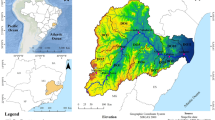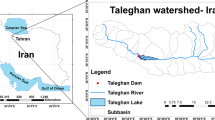Abstract
By now it has become a widespread, consistent practice in the European Union to consider very carefully and to regard as fundamental the basic needs of man, such as health and safety, in relation to all productive activities which may be regarded as a possible source of environmental deterioration. At the national legislative level, factors and elements regarding the environment (water, atmosphere, soil, subsoil, landscape, etc.) have been pointed out which require the state of quality to be characterised and vulnerability to the pressures caused by man's activities to be evaluated.
This has brought about an evolution in the concept itself of environmental quality, which is understood more and more as actual satisfying of man's needs through the proper use of resources and the maintaining of an environmental equilibrium.
Environmental quality can be pursued, therefore, by studying the most appropriate usage of the territory and by considering quality no longer as a hindrance, rule or imposition, but as a goal shared by all in improving the quality of life.
In this study a few instruments are proposed for evaluating the overall capacity of a given environmental element or group of elements to withstand deterioration caused by outside pressure, which in this specific case is pollution from farming and livestock waste and sewage.
Territorial vulnerability can thus be evaluated through a decision support tool (fuzzy logic), which allows different categories of people (researchers, politicians, planning technicians, citizens, etc.) to be involved in the evaluation process.
For this study, the vulnerability evaluation was applied to a complex, homogenous territorial system, the Tiber watershed, where there are environmental resources which are particularly sensitive, owing both to their intrinsic characteristics as well as to the pressures stemming from livestock production activities, which is one of the major pollution risks along the regional drainage pattern.
The use of GIS software has allowed the method of analysis and prioritising to be applied to environmental factors (weighting) as well as the rapid management of initial territorial data, also of differing types (qualitative and quantitative).
The resulting product is a vulnerability map where the territory is classified on the basis of the evaluations of the degree of response to stresses induced by the livestock production activities.
Similar content being viewed by others
References
Abbozzo, P., Mennella, V.G.G. 1993, L'impatto delle agro-tecnologie nel bacino del Tevere Franco Angeli Milano
Bettini, V. 1990. L'analisi ambientale CLUP Milano
Boggia, A., Duca, L. 1993 Analisi conoscitive per la valutazione di impatto ambientale della zootecnia intensiva nel bacino del Tevere in L'impatto delle agro-tecnologie nel bacino del Tevere Franco Angeli Milano
Caniglia C. 1994, L'ambiente è uno strumento? in Paesaggio Urbano, 1, 7–12
Di Plinio, G. 1994, Diritto pubblico dell' ambiente e aree naturali protette, Utet Torino
Giardini, L., 1991, Relazione Generale di Sintesi-Parte III in Agricoltura e Ambiente Accademia Nazionale di Agricoltura-Edagricole Bologna
Gisotti, G., Bruschi, S., 1990, Valutare l'ambiente, Nuova Italia Scientifica-Roma
Gomarasca M.A., Abbozzo P., Mennella V.G.G., 1994 Telerilevamento e SIT per l'analisi ambientale-Seminar 12 Aprile-Università di Perugia-Facoltà di Agraria
Govi, M., Ciavatta, C., 1993, Criteri di valutazione per la scelta nel bacino del Po di allevamenti suinicoli rappresentativi, con particolare riferimento alle caratteristiche degli effluenti in L'impatto delle agrotecnologie nel bacino del Po Franco Angeli Milano
Grillenzoni, M., Ragazzoni, A., 1993, Metodologie non monetarie in Valutazione delle risorse ambientali Edagricole Bologna
Guariso, G. 1990 Tecnologie informatiche e supporto alle decisioni ambientali in Terra, 60, 5-11-Patron Editore Bologna.
Malcevschi, S., 1990, Qualità ed impatto ambientale Etaslibri-Milano
Mennella V.G.G.; Borghi P., Macellari E.. 1994 Il bacino idrografico del Tevere. Studio della vulnerabilità del territorio Proceed. Nat. Conf. La nuova normativa nazionale sulle acque pubbliche: uso multiplo ed impatto sul territorio. Palermo 29–30 Settembre-Clamore Informazione & Comunicazione
Ministero delle risorse agricole alimentari e forestali, 1994, Codice di buona pratica agricola per la protezione delle acque da nitrati in Terra e vita, 11, Edagricole-Bologna
Paba, G. 1990, Ipotesi di un'urbanistica ben temperata in A.Magnaghi Il territorio dell'abitare-Franco Angeli-Milano
Saaty T.L., 1977, A scaling method for Priorities in Hierarchical Structures in Journal of mathematical psychology 15, 234–281.
Saaty T.L., 1989 Hierarchical-multiobjective systems in Control theory and advanced tecnology Vol.5 no 4, 485–498 Dec. Mita Press;
Saaty T.L., 1990 How to make a decision: The Analytic Hierarchy Process 0377/90/§03.50-Elsevier Science Publishers B.V.
Saaty, T.L. and J.M. Alexander, 1981 Thinking With Models Pergamon Press Oxford
Vianello, G., Sequi, P., 1993, La conoscenza delle caratteristiche pedoclimatiche nella classificazione del territorio in aree a differente grado di vulnerabilità ambientale in L'impatto delle agro-tecnologie nel bacini del Po Franco Angeli Milano
Zadeh, L.A., 1977 Fuzzy Set as a basis for a theory of possibility. Fuzzy Sets and Systems, 1, 3–28.
Author information
Authors and Affiliations
Rights and permissions
About this article
Cite this article
Mennella, V.G.G., Borghi, P., Macellari, E. et al. Territorial vulnerability evaluation in tiber watershed. Environ Monit Assess 41, 183–200 (1996). https://doi.org/10.1007/BF00394343
Issue Date:
DOI: https://doi.org/10.1007/BF00394343




